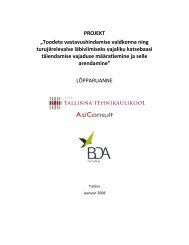Feasibility study for an Estonian Materials Technology Programme
Feasibility study for an Estonian Materials Technology Programme
Feasibility study for an Estonian Materials Technology Programme
Create successful ePaper yourself
Turn your PDF publications into a flip-book with our unique Google optimized e-Paper software.
80<br />
<strong>Feasibility</strong> <strong>study</strong> <strong>for</strong> <strong>an</strong> Estoni<strong>an</strong> <strong>Materials</strong> <strong>Technology</strong> <strong>Programme</strong><br />
4. Conclusions <strong>an</strong>d recommendations<br />
4.2 Mind-game: Extreme Future scenarios <strong>for</strong> materials technology in Estonia<br />
The following scenarios are a mind-game about what could happen if one of the following extremes happened.<br />
The scenarios only take into account the fact that national governmental funding c<strong>an</strong> be ch<strong>an</strong>ged<br />
<strong>an</strong>d makes assumptions of how the university <strong>an</strong>d the industry would react to these policy ch<strong>an</strong>ges. It also<br />
assumes that the overall amount of governmental funding remains the same during the following 5-10 years.<br />
All the assumptions are predictions based on the data gathered so far <strong>an</strong>d especially the point of the funding<br />
staying the same <strong>for</strong> 5-10 years depends very much on external funding sources such as the Europe<strong>an</strong><br />
Commission, the economy of the country <strong>an</strong>d the general science <strong>an</strong>d technology policy of the Estonia. The<br />
scenario that only fundamental research would be funded is not discussed as the benefits would take longer<br />
th<strong>an</strong> 10 years to realise.<br />
4.2.1 Extreme Scenario 1: National Governmental Funding given only to applied<br />
research that benefits the existing m<strong>an</strong>ufacturing industry<br />
Funding is mostly given to joint projects between comp<strong>an</strong>ies <strong>an</strong>d universities<br />
Some focus on which industries/themes should be selected to ensure real impact in the selected themes<br />
In 5-10 years<br />
The industry will have more educated people => more in-house R&D<br />
There are joint projects between universities <strong>an</strong>d industry<br />
Some comp<strong>an</strong>ies are moving up in the value chain<br />
All research is done based on comp<strong>an</strong>y needs<br />
Comp<strong>an</strong>ies are ready to invest more in R&D<br />
Comp<strong>an</strong>ies are starting to do joint R&D projects with <strong>for</strong>eign partners.<br />
Despite some comp<strong>an</strong>ies moving up the value chain, most likely m<strong>an</strong>y comp<strong>an</strong>ies have left the country<br />
or gone b<strong>an</strong>krupt due to higher personnel costs.<br />
Trade-off <strong>an</strong>d risks:<br />
Focus is on traditional business areas.<br />
No new business areas are likely to emerge.<br />
Unsure if this ef<strong>for</strong>t ensures global competiveness in 2020, especially if there are too m<strong>an</strong>y focus<br />
areas.<br />
Condition: Comp<strong>an</strong>ies are actively involved in R&D, ready to learn <strong>an</strong>d recruit people.<br />
4.2.2 Scenario 2: National Governmental Funding given only to applied research that<br />
benefits creation of new high-technology comp<strong>an</strong>ies<br />
To have <strong>an</strong> impact, this approach needs more public funding th<strong>an</strong> the previous scheme. The support is<br />
also needed <strong>for</strong> a longer period of time.<br />
There is more risk, but also much more opportunities to create new businesses <strong>an</strong>d renew <strong>an</strong>d modernize<br />
the industry.<br />
In 5-10 years<br />
Potentially a set of new comp<strong>an</strong>ies established in new business areas.<br />
Industry structure slowly renewing.<br />
New technologies will be developed in comp<strong>an</strong>ies.<br />
Impact on economy most likely still small<br />
High-tech comp<strong>an</strong>ies start to turn education in a new direction as more competent people are needed<br />
in these areas<br />
<strong>Materials</strong> technology comp<strong>an</strong>ies tend to grow additional business around them as they are at the<br />
beginning of the value-chain => new clusters will emerge.<br />
Trade-off <strong>an</strong>d risks:<br />
As the existing m<strong>an</strong>ufacturing industry should develop by itself with their own money there is a risk<br />
they won’t.<br />
The high-tech comp<strong>an</strong>ies don’t make it or they are bought out too early.<br />
A big risk is that venture capital is not found early enough.<br />
Fundamental research on a broad scale is not funded => too focused technology development?





